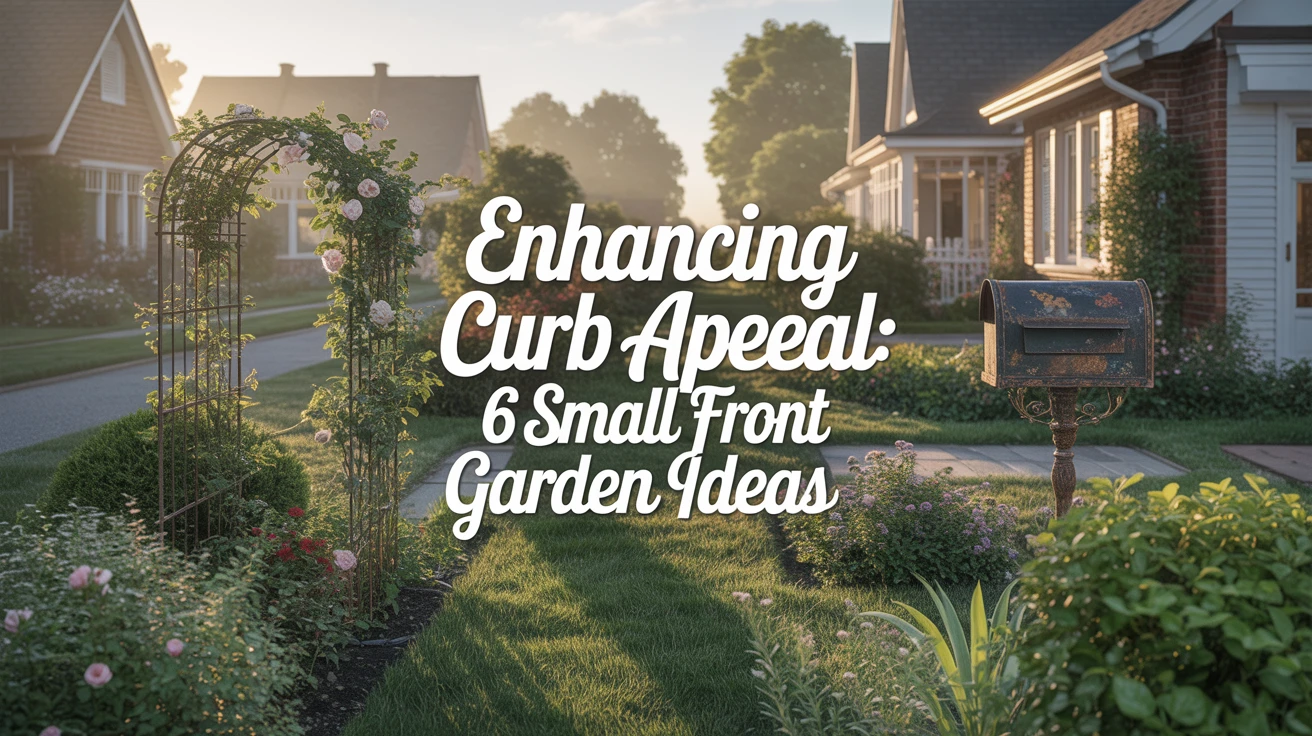
The Charm of a Well-Designed Small Front Garden
There’s something undeniably special about coming home to a beautiful front garden that welcomes you and your guests. As someone who’s transformed countless small front spaces, I can tell you that size truly doesn’t matter when it comes to creating impact. Even the tiniest front garden can dramatically enhance your home’s curb appeal with the right approach.
I remember my first home—a modest townhouse with barely 8 feet of garden space out front. What began as a neglected patch of weeds became the envy of the neighborhood with some creative thinking and weekend work. That experience taught me that small front garden ideas don’t need to be complicated or expensive to be effective.
In this article, I’ll share six proven strategies I’ve used with clients and in my own homes to maximize small front garden spaces. These approaches work regardless of your climate, budget, or gardening experience level.
1. Elevate Your Green Space with Vertical Gardens

When horizontal space is limited, the only way to go is up! Vertical gardening has revolutionized how I approach small front gardens. By utilizing walls, fences, and other vertical surfaces, you can dramatically increase your planting area without expanding your footprint.
I once worked with a client whose entire front garden was just 4 feet deep. By installing a simple trellis system on the house wall, we created a stunning display of climbing roses and clematis that drew compliments year-round.
- Wall-mounted planters – These come in countless styles, from formal to rustic, and can be arranged in patterns or groups
- Trellises and supports – Perfect for climbing plants like jasmine, ivy, or climbing roses
- Pocket planters – Fabric hanging systems that allow multiple plants in a small footprint
- Repurposed pallets – With some waterproofing, these make excellent vertical planting frames
The key is choosing plants suited to vertical growth. Some of my favorites include:
- Star jasmine for fragrance
- Boston ivy for rapid coverage
- Climbing hydrangea for shaded areas
- Strawberries and herbs for edible vertical gardens
Pro Tip: Install a drip irrigation system with your vertical garden to ensure consistent watering, especially for higher plantings that are difficult to reach. I learned this the hard way after losing an entire wall of beautiful petunias during a summer heatwave!
2. Embrace Flexibility with Container Gardening
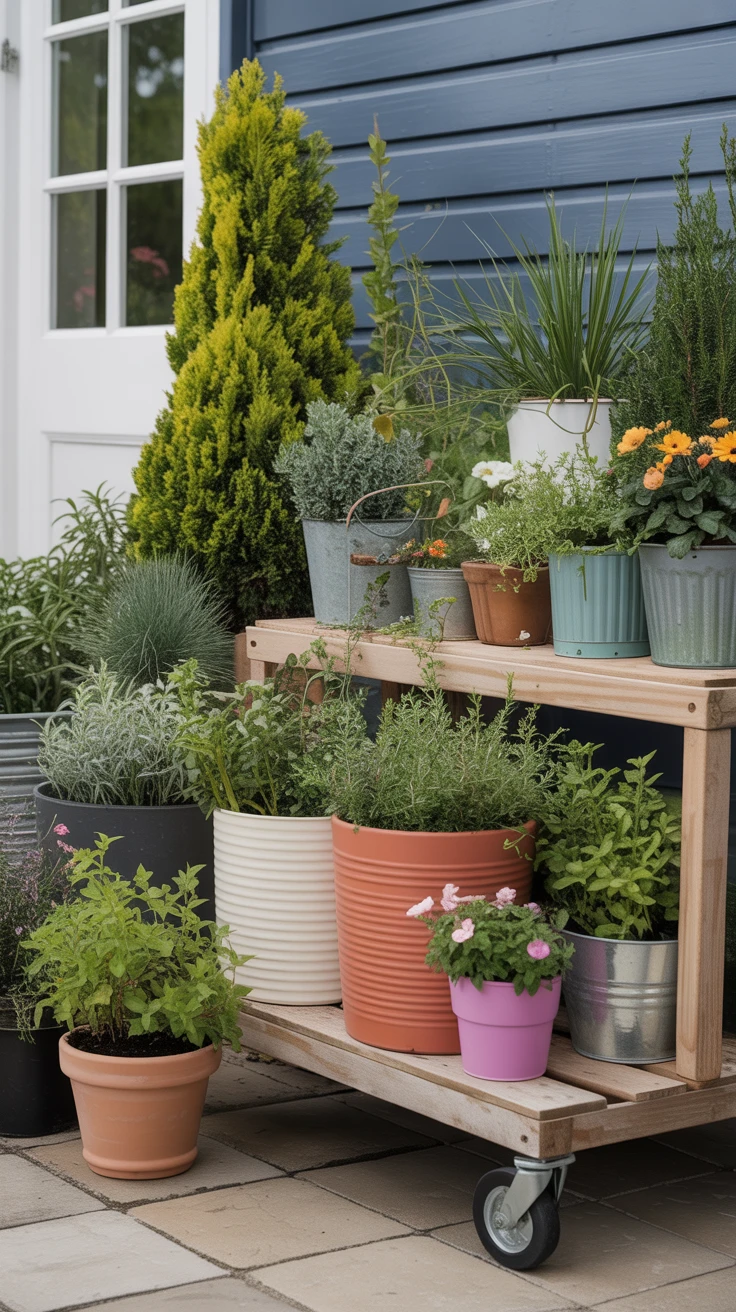
Container gardening changed my approach to small front garden ideas forever. The versatility of movable planters means you can rearrange your garden on a whim, experiment with different looks, and even take your favorite plants with you if you move.
I distinctly remember helping an elderly neighbor who couldn’t manage traditional gardening anymore. We created a container garden with lightweight pots on wheeled platforms that she could easily rearrange. It brought her gardening joy back!
For maximum impact in container gardens:
- Vary your heights – Mix tall, medium, and ground-level containers to create visual interest
- Group in odd numbers – Arrangements of 3, 5, or 7 containers look more natural than even numbers
- Consider material consistency – Using the same material (terracotta, ceramic, metal) creates cohesion
- Think about seasonal changes – Use containers that can withstand your climate year-round
The best plants for containers in front gardens include:
- Dwarf evergreens for year-round structure
- Ornamental grasses for movement
- Seasonal flowers for color bursts
- Herbs and small vegetables for practicality
3. Define Spaces with Pathways and Paving

Even the smallest front garden benefits from thoughtful pathways. I’ve found that defined walking areas not only guide visitors to your door but also create the illusion of a larger, more organized space.
My biggest pathway mistake came early in my gardening career when I installed a straight concrete path to my front door. It looked institutional and cold! I later replaced it with curved stepping stones surrounded by creeping thyme, which transformed the entire feel of the garden.
- Stepping stones – Natural or cast concrete stones create a casual, inviting path
- Gravel or pea stone – Affordable and permeable, with a pleasing crunch underfoot
- Brick or pavers – Classic options that can be laid in interesting patterns
- Wood chips or bark – Informal and natural-looking for cottage-style gardens
The shape of your path matters tremendously. While straight paths are efficient, curved ones slow the journey and make the space feel larger. I always encourage clients to think about how pathways can create “rooms” within even tiny front gardens.
Pro Tip: Add solar-powered path lights to illuminate walkways after dark. They enhance safety and create a magical nighttime ambiance that extends your enjoyment of the garden into evening hours.
4. Choose Wisely with Low-Maintenance Plants
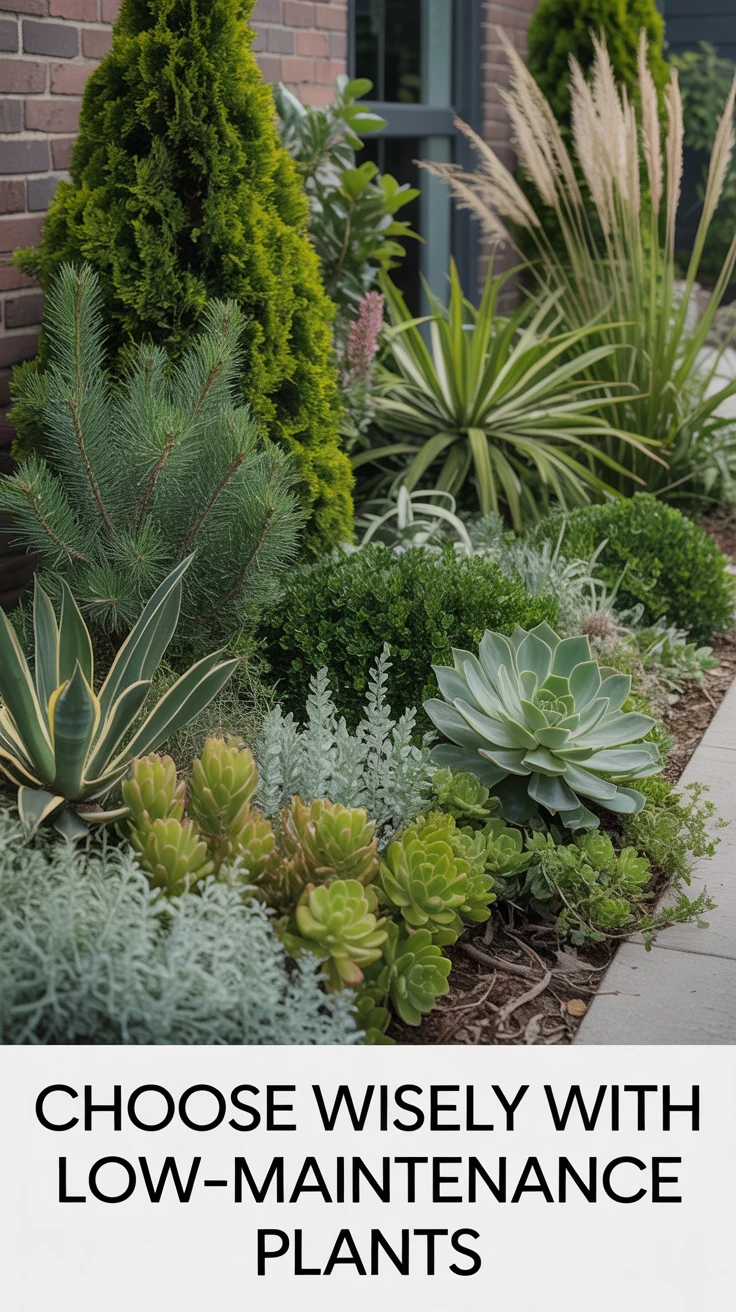
If there’s one lesson I’ve learned repeatedly, it’s that an ambitious planting scheme you can’t maintain will quickly become an eyesore. For most homeowners, small front garden ideas need to include low-maintenance plants that look good with minimal intervention.
I once planted a gorgeous but demanding cottage garden for a client who traveled frequently. Within months, it was overrun with weeds and the carefully selected perennials were struggling. We replanted with drought-tolerant, slow-growing varieties that thrived with occasional attention.
My go-to low-maintenance plants for front gardens include:
- Evergreen shrubs – Boxwood, juniper, and dwarf conifers provide year-round structure
- Ornamental grasses – Varieties like feather reed grass and blue fescue add movement with minimal care
- Native plants – Species adapted to your region will naturally require less maintenance
- Succulents – In suitable climates, these drought-resistant plants create striking displays
Remember that “low-maintenance” doesn’t mean “no maintenance.” Even the hardiest plants need some attention, especially in their first year while establishing.
5. Add Personality with Decorative Features
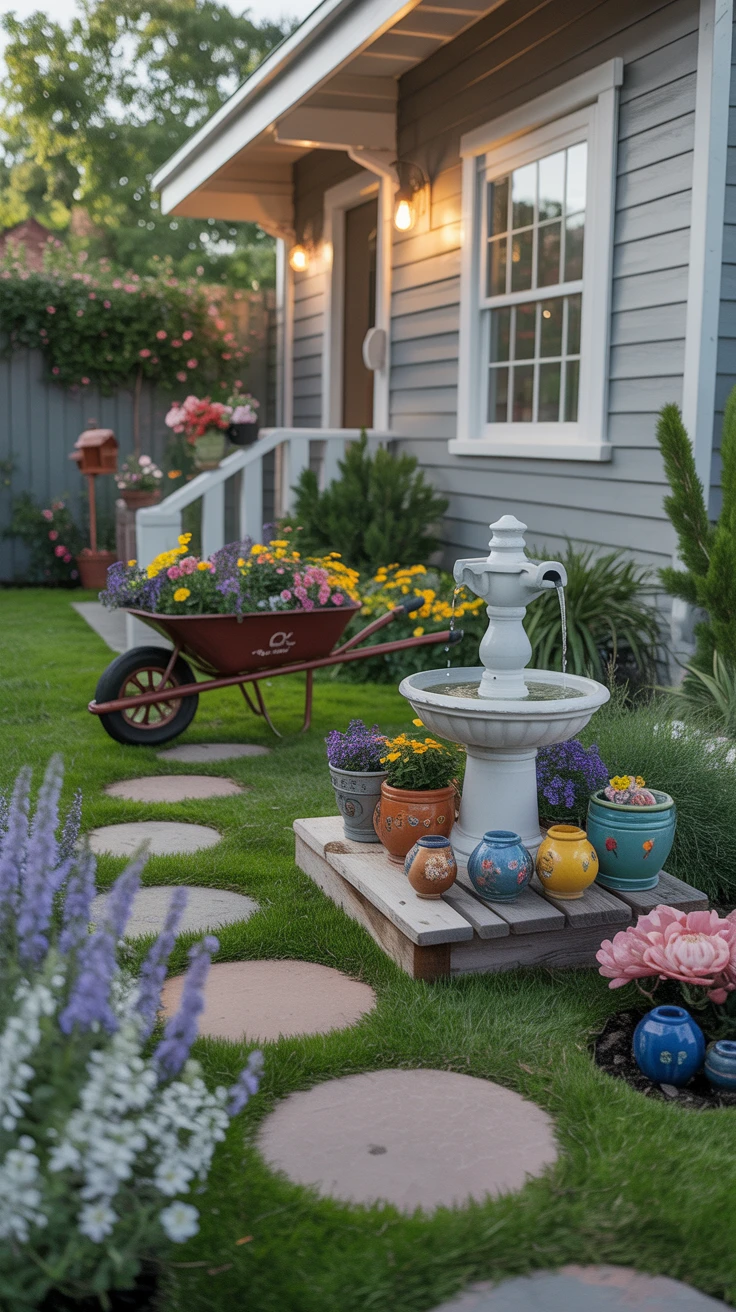
Gardens are expressions of personality, and decorative elements can make even the smallest front space uniquely yours. I’ve found that thoughtfully chosen features create focal points that draw the eye away from size limitations.
One of my favorite projects involved helping a retired art teacher incorporate her own ceramic creations into her tiny front garden. The colorful, whimsical pieces transformed a standard suburban space into a magical personal gallery that reflected her creative spirit.
Effective decorative elements for small front gardens include:
- Water features – Even small fountains create tranquil sounds and attract birds
- Sculpture or garden art – Choose pieces that weather well and reflect your taste
- Decorative mailboxes or house numbers – Functional items can become artistic statements
- Unusual containers – Repurposed items like old wheelbarrows or boots add character
The key is restraint—in small spaces, one or two standout decorative elements make more impact than numerous small items, which can create visual clutter.
6. Stay Current with Seasonal Gardening Tips
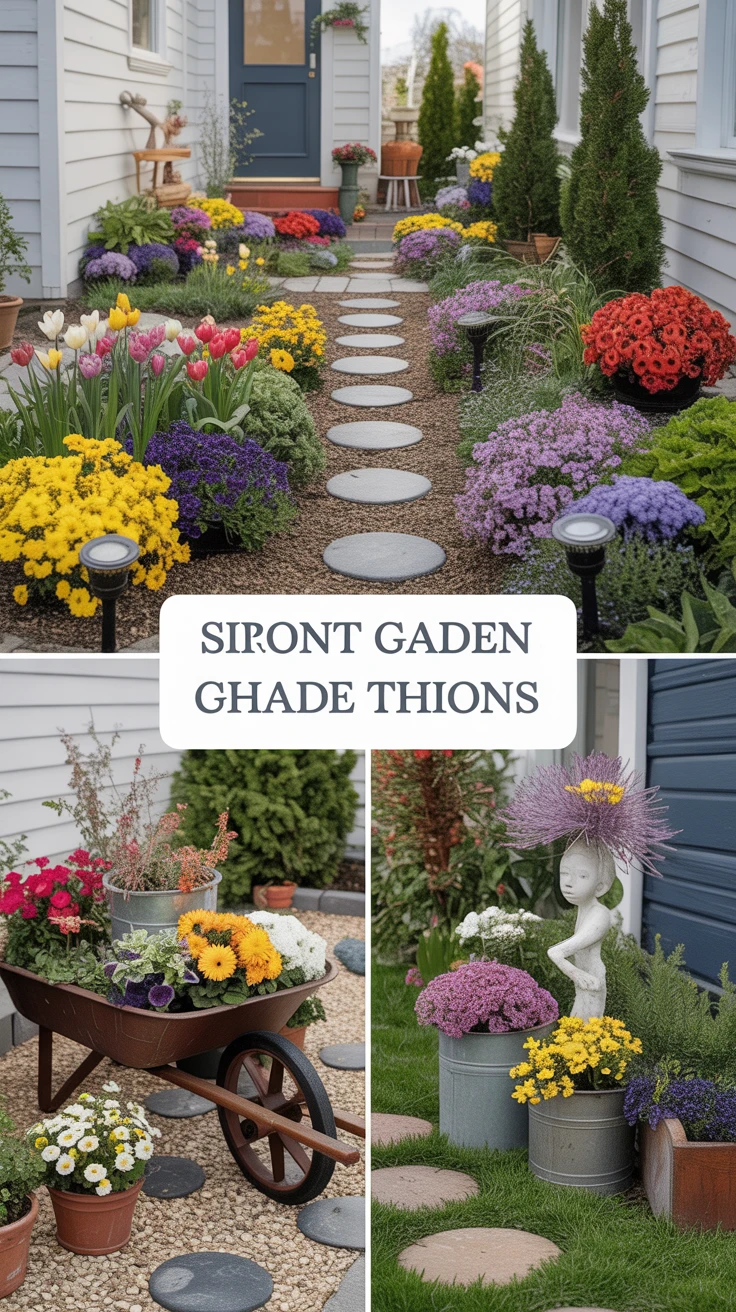
The most successful small front gardens I’ve designed change with the seasons, offering year-round interest. This approach ensures your garden never looks tired or neglected, regardless of the time of year.
I learned this lesson when I maintained the same winter arrangement in my front planters well into spring one year. A kind neighbor finally asked if I needed help “refreshing my sad winter pots.” I was mortified! Now I keep a gardening calendar with seasonal change reminders.
- Spring – Focus on bulbs like tulips and daffodils, plus early-flowering perennials
- Summer – Incorporate heat-loving annuals and perennials with long bloom periods
- Fall – Transition to autumn colors with chrysanthemums, ornamental kale, and grasses
- Winter – Rely on evergreens, berried plants, and interesting bark or branch structures
Consider creating a “backbone” of permanent plants that provide structure year-round, then supplement with seasonal elements in containers or dedicated planting pockets.
Pro Tip: Create a simple photographic record of your garden through the seasons to identify gaps in interest. I take monthly photos from the same spot and review them annually to see where seasonal improvements are needed.
Transform Your Front Garden Today

Implementing these small front garden ideas doesn’t require a complete overhaul all at once. I always advise clients to start with one concept that resonates most strongly with them, then build from there.
My own journey with small gardens has taught me that limitations often spark the most creative solutions. The constraints of a small front space can push you to make more thoughtful choices about every plant and feature.
Remember that gardens evolve over time. What you create today will grow, mature, and change in the coming seasons. Embrace this process and enjoy the journey of transforming your small front garden into a space that welcomes you home and enhances your property’s curb appeal.
Whether you have a weekend to dedicate or just a few hours here and there, each improvement you make to your front garden adds value to your home and joy to your daily life. Start small, be patient, and watch as your front garden becomes a source of pride and pleasure.

